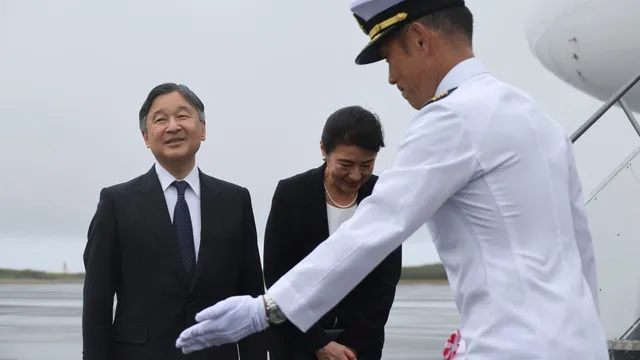
Emperor Naruhito honors war dead in historic Iwo Jima visit
2025-04-07 16:13- Emperor Naruhito and Empress Masako paid tribute at Iwo Jima on April 7, 2025.
- They prayed at memorials and met families of war victims as part of their visit.
- This visit highlights the importance of remembering wartime history for future generations.
Express your sentiment!
Insights
Japan's Emperor Naruhito and Empress Masako visited Iwo Jima on April 7, 2025, to pay tribute to those who lost their lives during one of World War II's most intense battles. The emperor's visit marks the couple's first trip to this significant site, as they commemorated the 80th anniversary of the battle, which unfolded between February 19 and March 26, 1945. During their visit, the Imperial couple prayed at three memorial sites and met with representatives of bereaved families and descendants of the island's former residents, acknowledging the enduring impact of wartime history and the importance of remembrance especially for younger generations. This notable visit follows a recent joint memorial service held by Japan and the United States, where officials and veterans gathered to honor the sacrifices made by both sides in the fierce combat for control of Iwo Jima. Notably, the battle was a critical turning point in the Pacific Theater of the war, resulting in the deaths of nearly all of the over 21,000 Japanese troops and around 7,000 U.S. soldiers, with many Japanese remains still unaccounted for. Emperor Naruhito's remarks earlier this year emphasized the significance of remembering such tragedies, as Japan's wartime actions under his grandfather's reign remain a complex and deeply reflective part of the nation’s history.
Contexts
The relations between Japan and the United States during World War II were marked by significant conflict and historical transformations that reshaped the dynamics of global politics. Prior to the war, diplomatic relations between both nations were characterized by tension and mistrust. The U.S. imposed economic sanctions and trade embargoes on Japan due to its aggressive military expansion in Asia, particularly the invasion of China and the occupation of French Indochina. These actions were a direct response to Japan's ambitions to dominate the Pacific region, and they escalated the already strained relations, ultimately leading to the notorious attack on Pearl Harbor on December 7, 1941. This surprise military strike aimed to incapacitate the U.S. Pacific Fleet and secure Japan’s dominance in Southeast Asia and the Pacific, marking the entry of the United States into World War II. In the wake of Pearl Harbor, the United States declared war on Japan, initiating a conflict that would last for nearly four years. The war in the Pacific was characterized by intense fighting in multiple theaters, with key battles such as Midway, Iwo Jima, and Okinawa illustrating the ferocity and scale of the conflict. The United States employed a strategy of island hopping, capturing strategic islands to move closer to Japan, while simultaneously conducting a relentless bombing campaign. The psychological and physical toll of warfare on both sides contributed to a deeply rooted animosity and profound changes in military tactics and operations. American forces faced brutal combat but also adapted remarkably, which ultimately led to significant territorial gains in the Pacific. The culmination of the war was marked by the U.S. decision to use atomic bombs on the Japanese cities of Hiroshima and Nagasaki in August 1945. These bombings resulted in massive civilian casualties and widespread destruction, hastening Japan’s surrender and the end of World War II. The bombings remain a subject of ethical debate, yet they were deemed necessary by U.S. leadership to avoid a potentially catastrophic invasion of the Japanese mainland and to hasten the conclusion of hostilities. On September 2, 1945, Japan formally surrendered aboard the USS Missouri, signaling a definitive end to the conflict while also laying the groundwork for a new era in bilateral relations. In the aftermath of World War II, Japan and the United States underwent a remarkable transformation from enemies to allies. The U.S. played a critical role in Japan's post-war reconstruction, providing financial assistance and guiding democratic reforms under the occupation led by General Douglas MacArthur. The San Francisco Peace Treaty of 1951 formally ended the state of war between the two nations and restored Japan's sovereignty. The U.S.-Japan Security Treaty followed, establishing a mutual defense arrangement that solidified a partnership based on shared interests in security and economic cooperation. This foundation has fostered a robust alliance that continues to influence regional and global dynamics into the 21st century, underpinning stability in Asia while promoting democratic values and economic growth.